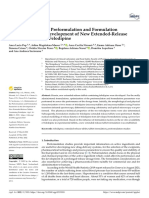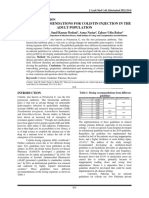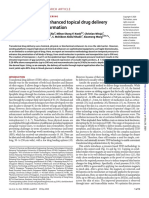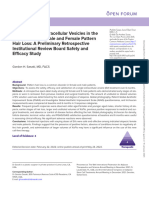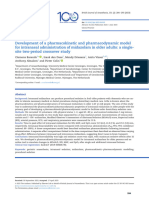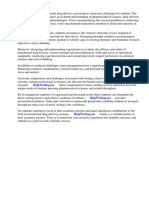Professional Documents
Culture Documents
3.1 - DAXI (DaxibotulinumtoxinA) - An Innovative Approach For Frown Lines, 2023.
Uploaded by
Ernesto Aragon RiosOriginal Title
Copyright
Available Formats
Share this document
Did you find this document useful?
Is this content inappropriate?
Report this DocumentCopyright:
Available Formats
3.1 - DAXI (DaxibotulinumtoxinA) - An Innovative Approach For Frown Lines, 2023.
Uploaded by
Ernesto Aragon RiosCopyright:
Available Formats
International Journal of General Medicine Dovepress
open access to scientific and medical research
Open Access Full Text Article
C O M M E N TA RY
DAXI (DaxibotulinumtoxinA) – An Innovative
Approach for Frown Lines
Abdullah Mussarat , Muhammad Saqlain Mustafa , Syed Talal Azam ,
Muhammad Musab Nafees uddin , Rana Muhammad Umer Nasrullah , Mohammad Arham Siddiq
Department of Medicine, Jinnah Sindh Medical University, Karachi, Pakistan
Correspondence: Mohammad Arham Siddiq, Department of Medicine, Jinnah Sindh Medical University, Iqbal Shaheed Road, Karachi, Pakistan,
Tel +923412127759, Email arhammusani99@gmail.com
Abstract: Glabellar frown lines, also known as worry lines, are a common sign of aging. The current treatment option for glabellar
lines is subjective and ranges from economical anti-wrinkle creams and skin resurfacing techniques such as microdermabrasion and
fillers to highly expensive facelifts. Botox® has been the mainstream treatment for decades, but the suggested time between treatments
for most toxins is 12–16 weeks, and evidence shows that patients being treated for glabellar lines want longer-lasting results. Recently,
on September 16th, the US Food and Drug Administration (FDA) approved the development of daxibotulinumtoxinA (DAXI) for
injection based on clinical trials (SAKURA 1, 2, and 3). These encouraging findings followed by FDA approval mean that the need for
repeated treatments to sustain the desired outcome has decreased. DAXI could be a reliable and secure choice for reducing the
appearance of wrinkles on the face caused by muscle activity, and its long duration has the potential to enhance the treatment of both
therapeutic and cosmetic disorders.
Keywords: glabellar lines, Botox, daxibotulinumtoxinA, SAKURA, wrinkles
Glabellar frown lines, also known as worry lines, are commonly perceived as a prominent sign of aging can manifest as
early as in 2nd decade of life.1 This is due to the contraction of various muscles including the corrugator, depressor
supercilii, and/or procerus muscles of the face, which leads to the formation of “brow furrows”, or gaps between
eyebrows. This may ultimately create a false impression of emotions such as anger or sorrow.2–6 Over decades repeated
contractions, smoking, and UV-radiation leads to thinning of the muscle and loss of muscle elasticity which may even be
visible as normal facial repose.7,8 As the majority of the population is affected by their physical appearance, these
wrinkles could potentially be a reason for low self-confidence, avoidance of social gatherings, and ultimately hampering
their well-being and quality of life.9 It was also found that people suffered from dysphoria not only mentally but
physically due to discrepancies between physical image and mental perception.10
When injected, botulinum toxin causes partial paralysis and atrophy by preventing pre-synaptic release of the
neurotransmitter (acetylcholine) at the neuromuscular junction and chemically denervating the muscle fiber
reversibly.11 One of the seven botulinum toxin serotypes (A-G), known as BoNT-A, is created by the gram-positive
anaerobic bacterium Clostridium botulinum. The authorized serotype A is not only limited to its cosmetology use in order
to treat glabellar lines but has an extended use in medical treatment for mild conditions like overactive bladder, chronic
migraine headaches, or serious conditions like upper limb spasticity, blepharospasm, and cervical dystonia. Despite the
fact that BoNTAs are frequently used for medicinal and cosmetic purposes, the duration of action is a drawback of all
currently available BoNTA products.12,13
The current treatment regime for treating glabellar lines is very subjective starting from economically friendly anti-
wrinkle creams, and skin resurfacing techniques like microdermabrasion, and fillers, to highly expensive facelift
surgeries.7 However, Botox®, a very familiar name among people, patients, and cosmetologists, has been the “main
stream” treatment for decades. Due to the results as quick as a few days while achieving maximum outcomes in 2–4
International Journal of General Medicine 2023:16 1267–1269 1267
Received: 10 February 2023 © 2023 Mussarat et al. This work is published and licensed by Dove Medical Press Limited. The full terms of this license are available at https://www.dovepress.com/terms.
Accepted: 2 April 2023 php and incorporate the Creative Commons Attribution – Non Commercial (unported, v3.0) License (http://creativecommons.org/licenses/by-nc/3.0/). By accessing the
work you hereby accept the Terms. Non-commercial uses of the work are permitted without any further permission from Dove Medical Press Limited, provided the work is properly attributed. For
Published: 10 April 2023 permission for commercial use of this work, please see paragraphs 4.2 and 5 of our Terms (https://www.dovepress.com/terms.php).
Mussarat et al Dovepress
weeks.14 The glabellar complex muscles can be injected to smooth out the muscles that cause frown lines. Currently,
AbobotulinumtoxinA (Dysport®), onabotulinumtoxinA (Botox®), and incobotulinumtoxinA (Xeomin®) are the three
BoNT-A products that are marketed and sold globally.15 The suggested time between treatments for the majority of
BoNTAs that are currently licensed in the USA is 12–16 weeks (3–4 months) and there is evidence that patients being
treated for glabellar lines want longer-lasting results.13
On September 16th, 2022, the US Food and Drug Administration (FDA) based on the promising findings of clinical
trials (SAKURA 1, 2, and 3) approved the development of daxibotulinumtoxinA (DAXI) for injection.16 The results
were calculated by a 2-point improvement in glabellar line severity according to both investigator and subject ratings
at maximum frown at week 4. Following three rounds of treatment with DAXI, the response rates were significantly
improved, with over 96% of patients experiencing no or mild severity of frown wrinkles, as evaluated by the
Investigator Global Assessment–Frown Wrinkle Severity (IGA-FWS) scale. The most substantial response was
observed between Weeks 2 and 4, indicating that the effects of the treatment were both rapid and long-lasting. The
SAKURA 1 and 2 studies, which included a combined total of 609 individuals, provided consistent results that
supported the high level of efficacy reported with DAXI.17 In order to further evaluate the safety profile of DAXI in
a significantly wider patient group and with a greater number of injectors, SAKURA 3—an expansion of the key Phase
3 studies—was conducted.18
An innovative, proprietary stabilizing peptide excipient (RTP004) that is substantially positively charged and attaches
to the negatively charged core neurotoxin is used in the formulation of DAXI. This particular peptide assures stability at
room temperature prior to reconstitution and enables the formulation of DAXI without the need for human serum
albumin (which is utilized in the existing BoNTA products).19 One of the distinguishing features that render this superior
to its peers is the lack of animal products used in its production. The other feature is its prolonged duration of
improvement for reducing glabellar line confirmed and expanded upon by the phase 3 data. In contrast to existing
licensed botulinum toxin products, DAXI for Injection offers prolonged efficacy between treatments and might enable
less frequent injections.20 Moreover, the DAXI procedure may lessen or eliminate mechanical stress in the glabellar
region as well as repetitive skin folding (and thus chronic stress applied to the dermis). It may also weaken the glabellar
complex muscles, which leads to an unopposed elevation and lifting effect from the (untreated) brow elevators. DAXI
therapy may have various effects including local muscle relaxation (which explains the early improvements in glabellar
lines) and tissue remodeling due to decreased muscle activity.21
Botulinum toxin is a very safe medicine with few side effects in therapeutic doses. A few adverse events were
documented in the SAKURA clinical trials of additional BoNTA products for the treatment of glabellar lines. Regardless
of the cause, headache, nasopharyngitis, injection site discomfort, and injection site erythema were the most frequent
adverse events (reported in less than 1% of patients). A total of 480 individuals overall (17.8%) out of 2691 had adverse
events associated with DAXI treatment. There were 31 significant adverse events, but none of them was thought to be
related to the treatment. BoNTA treatments need to be used again in order to maintain glabellar smoothness, therefore the
length of response should be considered while assessing the risk of adverse effects.22
The encouraging findings of SAKURA 1, 2 and 3 trials followed by FDA approval the need for repeated treatment to
sustain the desired outcome has decreased. In these clinical trials, patients reported a significant improvement in wrinkle
appearance and satisfaction with the treatment. DAXI could be a reliable and secure choice for lowering the appearance
of wrinkles on the face caused by muscle activity and its long duration has the capacity to enhance the treatment of both
therapeutic and cosmetic disorders, but it should be used only with proper consultation with a health care professional.
DAXI has limitations in pregnant and breastfeeding women. DAXI can be a relatively expensive treatment when
compared to other non-invasive wrinkle treatments. Further research is required to reduce the limitations and make it
cost-effective as compared to other available regimes.
Disclosure
The authors declare no potential conflicts of interest concerning the research, authorship, and/or publication of this
article.
1268 https://doi.org/10.2147/IJGM.S406563 International Journal of General Medicine 2023:16
DovePress
Powered by TCPDF (www.tcpdf.org)
Dovepress Mussarat et al
References
1. Wong QYA, Chew FT. Defining skin aging and its risk factors: a systematic review and meta-analysis. Sci Rep. 2021;11(1):22075. doi:10.1038/
s41598-021-01573-z
2. Charles finn J, Cox SE, Earl ML. Social implications of hyperfunctional facial lines. Dermatol Surg. 2003;29(5):450–455. doi:10.1046/j.1524-
4725.2003.29112.x
3. Coleman S, Grover R. The anatomy of the aging face: volume loss and changes in 3-dimensional topography. Aesthet Surg J. 2006;26(1):S4–S9.
doi:10.1016/j.asj.2005.09.012
4. Dayan S, Yoelin SG, De Boulle K, Garcia JK. The psychological impacts of upper facial lines: a qualitative, patient-centered study. Aesthet Surg
J Open Forum. 2019;1:2. doi:10.1093/asjof/ojz015
5. Yi K-H, Lee J-H, Hu H-W, Kim H-J. Novel anatomical guidelines on botulinum neurotoxin injection for wrinkles in the nose region. Toxins.
2022;14:342. doi:10.3390/toxins14050342
6. Yi KH, Lee JH, Hu HW, Kim HJ. Anatomical proposal for botulinum neurotoxin injection for glabellar frown lines. Toxins. 2022;14(4):268. PMID:
35448877; PMCID: PMC9032255. doi:10.3390/toxins14040268
7. Wrinkles; 2022. Available from: https://my.clevelandclinic.org/health/articles/10984-wrinkles. Accessed January 26, 2023.
8. Swift A, Liew S, Weinkle S, Garcia JK, Silberberg MB. The facial aging process from the “inside out”. Aesthet Surg J. 2021;41(10):1107–1119.
PMID: 33325497; PMCID: PMC8438644. doi:10.1093/asj/sjaa339
9. Cohen JL, Kaufman J, Peredo MI, Down R, Mashburn J. Assessment of psychological well-being after abobotulinumtoxina treatment:
a comparison of 2 reconstitution volumes. Dermatol Surg. 2020;46(2):289–292. doi:10.1097/dss.0000000000001940
10. Cosio T, Campione E. A new hypothesis in botulin therapy for depression: insula cortex modification. Dermatol Ther. 2019;32. doi:10.1111/
dth.13008
11. Lagueny A, Burbaud P. Mécanisme d’action, indication et résultats des traitements par la toxine botulinique [Mechanism of action, clinical
indication and results of treatment of botulinum toxin]. Neurophysiol Clin. 1996. 26(4):216–226. French. PMID: 8975111. doi:10.1016/s0987-
7053(96)85003-9
12. Pirazzini M, Rossetto O, Eleopra R, Montecucco C. Botulinum neurotoxins: biology, pharmacology, and toxicology. Pharmacol Rev. 2017;69
(2):200–235. doi:10.1124/pr.116.012658
13. Solish N, Carruthers J, Kaufman J, et al. Overview of daxibotulinumtoxinA for injection: a novel formulation of botulinum toxin type A. Drugs.
2021;81:2091–2101. doi:10.1007/s40265-021-01631-w
14. Kaufman-Janette J, Cox SE, Dayan S, Joseph J. Botulinum toxin type A for glabellar frown lines: what impact of higher doses on outcomes?
Toxins. 2021;13(7):494. doi:10.3390/toxins13070494
15. Field M, Splevins A, Picaut P, et al. AbobotulinumtoxinA (Dysport®), OnabotulinumtoxinA (Botox®), and incobotulinumtoxinA (Xeomin®)
neurotoxin content and potential implications for duration of response in patients. Toxins. 2018;10(12):535. PMID: 30551641; PMCID:
PMC6316182. doi:10.3390/toxins10120535
16. Revance announces FDA approval of DAXXIFY™ (daxibotulinumtoxinA-lanm) for injection, the first and only peptide-formulated neuromodu
lator with long-lasting results; 2023. Available from: https://www.businesswire.com/news/home/20220908005320/en. Accessed: January 26, 2023.
17. Carruthers JD, Fagien S, Joseph JH, et al. DaxibotulinumtoxinA in the treatment of glabellar lines: results from each of two multicenter,
randomized, double-blind, placebo-controlled phase 3 studies (SAKURA 1 and SAKURA 2). Plast Reconstr Surg. 2020;145:45–58.
18. Fabi SG, Cohen JL, Green LJ. DaxibotulinumtoxinA for injection for the treatment of glabellar lines: efficacy results from SAKURA 3, a large,
open-label, phase 3 safety study. Dermatol Surg. 2021;47(1):48–54. doi:10.1097/DSS.0000000000002531
19. Malmirchegini R, Too P, Oliyai C, Joshi A. Revance’s novel peptide excipient, RTP004, and its role in stabilizing daxibotulinumtoxinA (DAXI)
against aggregation. Toxicon. 2018;156:S72–3. doi:10.1016/j.toxicon.2018.11.174
20. Bertucci V, Solish N, Kaufman-Janette J, et al. DaxibotulinumtoxinA for injection has a prolonged duration of response in the treatment of glabellar
lines: pooled data from two multicenter, randomized, double-blind, placebo-controlled, phase 3 studies (SAKURA 1 and SAKURA 2). J Am Acad
Dermatol. 2020;82(4):838–845. PMID: 31791824. doi:10.1016/j.jaad.2019.06.1313
21. Glogau R, Kontis TC, Liu Y, Gallagher CJ. Progressive improvement in static glabellar lines after repeated treatment with daxibotulinumtoxinA for
injection. Dermatol Surg. 2021;47(12):1579–1584. PMID: 34417396; PMCID: PMC8612903. doi:10.1097/DSS.0000000000003211
22. Green JB, Mariwalla K, Coleman K, et al. A large, open-label, phase 3 safety study of daxibotulinumtoxinA for injection in glabellar lines: a focus
on safety from the SAKURA 3 study. Dermatol Surg. 2021;47:42–46. doi:10.1097/DSS.0000000000002463
International Journal of General Medicine Dovepress
Publish your work in this journal
The International Journal of General Medicine is an international, peer-reviewed open-access journal that focuses on general and internal
medicine, pathogenesis, epidemiology, diagnosis, monitoring and treatment protocols. The journal is characterized by the rapid reporting of
reviews, original research and clinical studies across all disease areas. The manuscript management system is completely online and includes a
very quick and fair peer-review system, which is all easy to use. Visit http://www.dovepress.com/testimonials.php to read real quotes from
published authors.
Submit your manuscript here: https://www.dovepress.com/international-journal-of-general-medicine-journal
International Journal of General Medicine 2023:16 DovePress 1269
Powered by TCPDF (www.tcpdf.org)
You might also like
- MIL Q3 Module 5 REVISEDDocument23 pagesMIL Q3 Module 5 REVISEDEustass Kidd68% (19)
- Case Study 2022 - HeyJobsDocument6 pagesCase Study 2022 - HeyJobsericka.rolim8715No ratings yet
- Castigliano's 2nd TheoremDocument29 pagesCastigliano's 2nd TheoremMiddle East100% (4)
- Cassandra Training 3 Day CourseDocument5 pagesCassandra Training 3 Day CoursedsunteNo ratings yet
- Development and Optimization of Acyclovir Loaded Mucoadhesive Microspheres by Box - Behnken DesignDocument13 pagesDevelopment and Optimization of Acyclovir Loaded Mucoadhesive Microspheres by Box - Behnken DesignMayeenNo ratings yet
- Ccid 16 911Document14 pagesCcid 16 911maria bethania martins leiteNo ratings yet
- Regenerative Technologies To Bed Side: Evolving The Regulatory FrameworkDocument7 pagesRegenerative Technologies To Bed Side: Evolving The Regulatory FrameworkGuillermo L. PeñalvaNo ratings yet
- In Vitro Dissolution Study and Assay of Diclofenac Sodium From Marketedsolid Dosage Form in Bangladesh 1948 593X 1000164Document6 pagesIn Vitro Dissolution Study and Assay of Diclofenac Sodium From Marketedsolid Dosage Form in Bangladesh 1948 593X 1000164nakitaNo ratings yet
- The Interchangeability of Doxycycline Tablets NotDocument6 pagesThe Interchangeability of Doxycycline Tablets NotAlexandra CociuNo ratings yet
- Dexamethasone-Loaded Ureasil Hydrophobic Membrane For Bone Guided RegenerationDocument16 pagesDexamethasone-Loaded Ureasil Hydrophobic Membrane For Bone Guided RegenerationJoao Augusto Oshiro JuniorNo ratings yet
- Efficacy of Botulinum Toxin in Masseter Muscle Hypertrophy For Lower FaceDocument8 pagesEfficacy of Botulinum Toxin in Masseter Muscle Hypertrophy For Lower FaceAbdelrahmanNo ratings yet
- Patofisiologi NebulizerDocument11 pagesPatofisiologi NebulizerdennyramdhanNo ratings yet
- Application of Coating Technology To Chronothera - 2021 - Current Research in PHDocument9 pagesApplication of Coating Technology To Chronothera - 2021 - Current Research in PHZac IngNo ratings yet
- Association Between Use of Systemic and Inhaled Glucocorticoids and Changes in Brain Volume and White Matter MicrostructureDocument72 pagesAssociation Between Use of Systemic and Inhaled Glucocorticoids and Changes in Brain Volume and White Matter MicrostructureRoel PlmrsNo ratings yet
- Systemic Delivery of B-Blockers Via Transdermal Route For HypertensionDocument16 pagesSystemic Delivery of B-Blockers Via Transdermal Route For HypertensionSai HS BodduNo ratings yet
- Nanocrystals As Drug Delivery SystemDocument11 pagesNanocrystals As Drug Delivery SystemEditor IJTSRDNo ratings yet
- Botulinum Toxin Treatment For Mild To Moderate PlaDocument7 pagesBotulinum Toxin Treatment For Mild To Moderate PlaCătălina RamoNo ratings yet
- Sustained Release Matrix Tablet of Diltiazem Hydrochloride It'S Formulation and EvaluationDocument10 pagesSustained Release Matrix Tablet of Diltiazem Hydrochloride It'S Formulation and EvaluationruriNo ratings yet
- Formulation Development and Evaluation of Sustained Release Tablet Chlorpromazine HCLDocument7 pagesFormulation Development and Evaluation of Sustained Release Tablet Chlorpromazine HCLWJPSR JournalNo ratings yet
- Sciadv Abd3083 Full PDFDocument11 pagesSciadv Abd3083 Full PDFjudith retanaNo ratings yet
- Mouth Dissolving Tablets A ReviewDocument9 pagesMouth Dissolving Tablets A ReviewEditor IJTSRDNo ratings yet
- 1 s2.0 S0378517323006452 MainDocument10 pages1 s2.0 S0378517323006452 MainClaudia Elizabeth Ruiz DávilaNo ratings yet
- Collagen StimulatorsDocument11 pagesCollagen StimulatorsElizabeth TovittoNo ratings yet
- Applsci 12 05333Document25 pagesApplsci 12 05333juanNo ratings yet
- Low-Cost Measurement of Facemask Efficacy For Filtering Expelled Droplets During SpeechDocument11 pagesLow-Cost Measurement of Facemask Efficacy For Filtering Expelled Droplets During SpeechJacob ObboNo ratings yet
- Colistin Guideline PaperDocument5 pagesColistin Guideline PaperRimsha AzeemNo ratings yet
- A Review On Bilayer Tablet Dosage Form Development and It's Various Advancement in Field of Bilayer TabletDocument15 pagesA Review On Bilayer Tablet Dosage Form Development and It's Various Advancement in Field of Bilayer TabletResearch ParkNo ratings yet
- 2022 09 06 22279656v1 FullDocument29 pages2022 09 06 22279656v1 FullRodrigo SilvaNo ratings yet
- Toxins 13 00169 v3Document16 pagesToxins 13 00169 v3Daniela RodriguesNo ratings yet
- Ccid 13 31Document18 pagesCcid 13 31Ananda SantosNo ratings yet
- Formulation Development and in Vitro Evaluation of Capecitabine Immediate Release TabletsDocument9 pagesFormulation Development and in Vitro Evaluation of Capecitabine Immediate Release TabletsEditor IJTSRDNo ratings yet
- Basem AbdelmalakDocument12 pagesBasem AbdelmalakRonaldi MarsvinNo ratings yet
- Pmfnews 13 10 0710Document12 pagesPmfnews 13 10 0710linhNo ratings yet
- 02 AJPHS Jan-Mar 2016 738 PDFDocument7 pages02 AJPHS Jan-Mar 2016 738 PDFSami SamiNo ratings yet
- Temporal Pressure Enhanced Topical Drug Delivery Through Micropore FormationDocument14 pagesTemporal Pressure Enhanced Topical Drug Delivery Through Micropore FormationMuhammadRomadonSyolehhudinNo ratings yet
- Microfluidic Manufacture LNPDocument45 pagesMicrofluidic Manufacture LNPamin rahmaniNo ratings yet
- European Journal of Pharmaceutics and BiopharmaceuticsDocument11 pagesEuropean Journal of Pharmaceutics and BiopharmaceuticsboniatNo ratings yet
- Comparative in Vivo Study On Quality Analysis On Bisacodyl of Different BrandsDocument17 pagesComparative in Vivo Study On Quality Analysis On Bisacodyl of Different BrandsIJRASETPublicationsNo ratings yet
- Effects of Hydrolysed Collagen Associated or Not With Physical AgentsDocument17 pagesEffects of Hydrolysed Collagen Associated or Not With Physical Agentssilvia roca mejiaNo ratings yet
- Botulinum Toxin in Aesthetic Medicine Myths and RealitiesDocument12 pagesBotulinum Toxin in Aesthetic Medicine Myths and RealitiesЩербакова ЛенаNo ratings yet
- Ceramide - Transdermal TherapyDocument20 pagesCeramide - Transdermal TherapyBiology BảoNo ratings yet
- Toxina Botulinica PDFDocument24 pagesToxina Botulinica PDFReynaldo Miranda AlarcónNo ratings yet
- 2022 Clinical Use of Extracellular Vesicles in The Management ofDocument15 pages2022 Clinical Use of Extracellular Vesicles in The Management ofjosiane.caroline26No ratings yet
- Jepretan Layar 2022-12-03 Pada 01.42.13Document44 pagesJepretan Layar 2022-12-03 Pada 01.42.13Arumm88No ratings yet
- Stability Study For Three Brands Co-Amoxiclav Oral Suspension (312.5/5Ml) After Reconstitution at Refrigerator (2-8°C)Document9 pagesStability Study For Three Brands Co-Amoxiclav Oral Suspension (312.5/5Ml) After Reconstitution at Refrigerator (2-8°C)Davy JonesNo ratings yet
- Profhilo - CoesividadeDocument9 pagesProfhilo - CoesividadeRhelvis1No ratings yet
- Bilayer Tablets - A Developing Novel Drug Delivery SystemDocument11 pagesBilayer Tablets - A Developing Novel Drug Delivery SystemTatenda BrunoNo ratings yet
- Applied Anatomy of The Layers and Soft 17421491Document9 pagesApplied Anatomy of The Layers and Soft 17421491marioNo ratings yet
- The Future of Drug DeliveryDocument9 pagesThe Future of Drug Deliverylol pookNo ratings yet
- In Vitro and in Vivo Characterization of MEMS MicroneedlesDocument6 pagesIn Vitro and in Vivo Characterization of MEMS MicroneedlesAndisheh ChoupaniNo ratings yet
- Diazepam Od TDocument7 pagesDiazepam Od TnurulNo ratings yet
- Bioengineering 11 00259Document18 pagesBioengineering 11 00259jamel-shamsNo ratings yet
- Wolff Velten Intelligent Intraoral Drug Delivery Microsystem JMES 2006Document10 pagesWolff Velten Intelligent Intraoral Drug Delivery Microsystem JMES 2006Krupali JainNo ratings yet
- GlutationeDocument5 pagesGlutationeDanister L. PereraNo ratings yet
- Docket No. FDA-2016-N-0124: Department of Health and Human ServicesDocument7 pagesDocket No. FDA-2016-N-0124: Department of Health and Human Servicesgerardo sifuentesNo ratings yet
- Botulinum Toxin Off-Label Use in Dermatology: A ReviewDocument18 pagesBotulinum Toxin Off-Label Use in Dermatology: A ReviewrizkaNo ratings yet
- Injeksi KonjungtivaDocument24 pagesInjeksi KonjungtivataufikNo ratings yet
- Midazolan Intranasal en AdultoDocument10 pagesMidazolan Intranasal en Adultoheiddy MendozaNo ratings yet
- Published ArticleDocument15 pagesPublished ArticleOktavia Rahayu ANo ratings yet
- Thesis On Transdermal Drug Delivery SystemDocument8 pagesThesis On Transdermal Drug Delivery SystemOrderPapersOnlineWorcester100% (2)
- Kyobula Et Al. - 2017 - 3D Inkjet Printing of Tablets Exploiting Bespoke CDocument9 pagesKyobula Et Al. - 2017 - 3D Inkjet Printing of Tablets Exploiting Bespoke CJose Rafael Cerda CespedesNo ratings yet
- Intralesional Corticosteroid Administration in The Treatment of Keloids: A Scoping Review On Injection MethodsDocument16 pagesIntralesional Corticosteroid Administration in The Treatment of Keloids: A Scoping Review On Injection MethodsAndrés Felipe Yepes OsorioNo ratings yet
- Optimizinh Hyroxycloroquine Use in COVID 19Document16 pagesOptimizinh Hyroxycloroquine Use in COVID 19احمد علىNo ratings yet
- Drug-Coated Balloons: Applications in Interventional CardiologyFrom EverandDrug-Coated Balloons: Applications in Interventional CardiologyBernardo CorteseNo ratings yet
- Abcs Booklet Kidney-Stones PDFDocument20 pagesAbcs Booklet Kidney-Stones PDFDendhy Dwi Handana SagitaNo ratings yet
- Why I Want To Be An Army OfficerDocument1 pageWhy I Want To Be An Army OfficercmphalanNo ratings yet
- 87844-Chapter 1. The Psychology of TourismDocument28 pages87844-Chapter 1. The Psychology of TourismVENA LANDERONo ratings yet
- Cambridge Latin Course Book I Vocabulary Stage 1 Stage 2Document3 pagesCambridge Latin Course Book I Vocabulary Stage 1 Stage 2Aden BanksNo ratings yet
- Worksheet For Mathematics For ManagementDocument3 pagesWorksheet For Mathematics For Managementabel shimeles100% (1)
- HF CharactersDocument5 pagesHF CharactersAudri DebnathNo ratings yet
- Machine DesignDocument34 pagesMachine DesignMohammed Yunus33% (3)
- The Impact of Climatic and Cultural Factors On Openings in Traditional Houses in MaharashtraDocument14 pagesThe Impact of Climatic and Cultural Factors On Openings in Traditional Houses in Maharashtracoldflame81No ratings yet
- CPN Project TopicsDocument1 pageCPN Project TopicsvirginNo ratings yet
- Ready For First TB Unit3Document10 pagesReady For First TB Unit3Maka KartvelishviliNo ratings yet
- Rulings On MarriageDocument17 pagesRulings On MarriageMOHAMED HAFIZ VYNo ratings yet
- Chapter 2Document14 pagesChapter 2Um E AbdulSaboorNo ratings yet
- Proofs in Indian Mathematics: M.D.SrinivasDocument40 pagesProofs in Indian Mathematics: M.D.SrinivasShashankNo ratings yet
- Chapter 4 Nuc - PhyDocument11 pagesChapter 4 Nuc - PhyHaris ShahidNo ratings yet
- Schemes and Tropes HandoutDocument6 pagesSchemes and Tropes HandoutJohn LukezicNo ratings yet
- Chapter 11 Waiting Line ModelsDocument46 pagesChapter 11 Waiting Line ModelsLara FloresNo ratings yet
- Aswini Expert SystemsDocument37 pagesAswini Expert SystemsKarishma Satheesh KumarNo ratings yet
- Kuo SzuYu 2014 PHD ThesisDocument261 pagesKuo SzuYu 2014 PHD ThesiskatandeNo ratings yet
- 1386258018727Document21 pages1386258018727Roberto MuñozNo ratings yet
- Physical Education 10 WEEK 2Document10 pagesPhysical Education 10 WEEK 2Israel MarquezNo ratings yet
- MQM100 MultipleChoice Chapter2Document9 pagesMQM100 MultipleChoice Chapter2Nakin KNo ratings yet
- 7 Strategies To Assess Learning NeedsDocument11 pages7 Strategies To Assess Learning Needshammouam100% (1)
- Short Tutorial On Recurrence RelationsDocument13 pagesShort Tutorial On Recurrence RelationsAbdulfattah HusseinNo ratings yet
- How To Read A Research PaperDocument16 pagesHow To Read A Research PaperHena Afridi100% (1)
- Beginner Levels of EnglishDocument4 pagesBeginner Levels of EnglishEduardoDiazNo ratings yet
- Hapter 2: Theoretical FrameworkDocument18 pagesHapter 2: Theoretical FrameworkMohamed HamzaNo ratings yet























